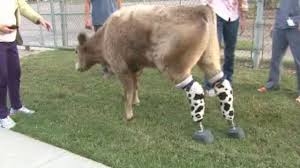Using High-Tech To Find Homes
Adi Pinhas, PetMatch
 Adi Pinhas was using facial recognition technology in his iPhone app. You uploaded a picture of the pet you wanted and it would tell you all the adoptable animals that looked like the original picture.
Adi Pinhas was using facial recognition technology in his iPhone app. You uploaded a picture of the pet you wanted and it would tell you all the adoptable animals that looked like the original picture.
Adi Pinhas originally worked on this technology for other purposes, allowing you to find images with similar content or similar objects and could work on anything. In their grand visions, they were going to release different applications that could do other things, but thought it would be useful to start with pets.
PetMatch let you upload a picture of a dog or cat, or use one from its gallery. It then searched databases and tried to find you a pet available for adoption that was the closest possible match to the one you posted, out of the millions that were available.
If you combined several photos to make the perfect pet, would PetMatch be able to find the animal? The answer was yes! People were even using images of stuffed animals.
Of course, it wasn't perfect. If the picture you uploaded showed an animal at an odd angle, was blurry or otherwise differred from typical shots by animal-rescue groups, there was no telling what it would return for you.
Unfortunately, its ad-injecting software was discovered to have a severe security vulnerability. The company then changed its name to "JustVisual" and discontinued its ad-injecting practices.
Visit Website
Pets In The Classroom
Brent Weinmann, Pet Care Trust
 Research says kids learn better when their classroom has a pet. Even truancy goes down. We all remember the class pet. And if you were lucky, the teacher let you take the guinea pigs home for the summer. Brent Weinmann of the Pet Care Trust makes sure all kids get an opportunity to have pets in their classroom.
Research says kids learn better when their classroom has a pet. Even truancy goes down. We all remember the class pet. And if you were lucky, the teacher let you take the guinea pigs home for the summer. Brent Weinmann of the Pet Care Trust makes sure all kids get an opportunity to have pets in their classroom.
Pet Care Trust is an organization that was started many years ago through contributions from companies within the pet industry. Their original mission was to figure out how to introduce more people to pets and the joys of pet ownership. They also wanted to make sure it was done in a responsible way. Their main focus has been on kids and to bring pets into the classrooms.
Before a classroom can have a pet, it is the responsibility of the teacher to clear the way with their administration. The Pet Care Trust will then make grants available either directly through the trust or with the cooperation of large national retailers, to help facilitate getting these pets into the classrooms. They try to minimize costs as much as they can, because they know that these types of things usually come directly out of the teachers' pockets.
Pet Care Trust will fund the costs of the cage setup, initial food purchase, toys, treats, bedding, decorations, etc., based upon the type of pet that's chosen. They will also fund part of the animal. The schools will not get a free animal; the school will have to pay part of the purchase. Pet Care Trust feels this will ensure commitment and care from the school for the wellbeing of the animal. But at the same time, they will work with the retailer and the teacher to keep the cost of the pet down.
 Pet Care Trust, along with pet retailers, have made a list of pets that their vets have deemed appropriate for most classrooms. The teacher can then pick from that list the pet they would like to have in their classroom.
Pet Care Trust, along with pet retailers, have made a list of pets that their vets have deemed appropriate for most classrooms. The teacher can then pick from that list the pet they would like to have in their classroom.
Brent states that some classrooms have done field trips or online research to figure out what type of pet would be best. They then do a vote and the kids decide what they would like to have in the classroom.
But what happens to these pets on weekends or in the summer? Sometimes the teacher takes them home or the students will split the duties.
While everyone knows there are benefits to having pets in the classroom, such as encouraging pet ownership at home, there is a study going on to see just what the true benefits are. Could they reduce truancy, reduce bullying, encourage kids to read?
Brent also tells us stories from teachers about children who are uncomfortable or on the autism spectrum. When the teachers know these children are having an especially rough time, they allow them to interact with the animals, which calms them down and gets them back in a better place.
It's a win-win situation for everyone!
Visit Website
"HERO PERSON OF THE WEEK" - Kelly Martin, Selah Ranch All Animal Rescue
 Kitty Martin loved her calf so much that she put more than $40,000 into rescuing the steer after it's back legs were amputated because of frostbite. She's the Hero Person this week with a great story to tell about the human-bovine connection.
Kitty Martin loved her calf so much that she put more than $40,000 into rescuing the steer after it's back legs were amputated because of frostbite. She's the Hero Person this week with a great story to tell about the human-bovine connection.
Kitty was running a small private rescue when someone called her about a calf that had froze to the ground and lost two back hoofs and part of his tail to frostbite. She said when she saw the calf, it was more horrible than she expected. Kitty felt that he had such a rough start in life, she decided to swing for him and named him Hero.
His mother originally rejected Hero and the farmer then sold him to someone who felt they could raise him on a bottle. This wasn't done properly and the calf got weak and couldn't get up off the ground. The weather at the time was freezing, so the little calf just froze to the ground.
Kitty didn't know what to do with Hero, but did some research and found out that this procedure had been done before on another cow named Meadow. The procedure included removing 2-inches of bone and bringing the tendons around to make a pad stump, which was then fitted with prosthetics. Hero had three sets of prosthetics, which were black and white and looked like a Holstein cow.
Kitty was told he would never be able to run and kick, but Hero proved everyone wrong!
Some people thought it would have been more humane to euthanize Hero. Kitty says this whole thing has attracted some of the world's best and some of the world's worst towards her. Unfortunately, Hero has since passed away.
Visit Website
Pet Flipping - Seven Tips to Safeguard Your Pet - Dr. Debbie
 Pet lovers beware of the disturbing criminal trend called "pet flipping." This is when a person steals a pet or takes ownership of a lost pet, and then sells the animal. Pets are typically sold on the Internet to make a quick profit.
Pet lovers beware of the disturbing criminal trend called "pet flipping." This is when a person steals a pet or takes ownership of a lost pet, and then sells the animal. Pets are typically sold on the Internet to make a quick profit.
Pet flippers most commonly target purebred dogs because they can fetch a high price, but even mixed breed dogs are at risk. Dogs are swiped from porches, fenced in back yards, dog parks, and cars. Some pet scams involve a person advertising as a pet sitter or trainer, who then disappears with your pet. Other scams involve someone who steals a pet and then responds to the lost pet ad, making money on rewards.
Top 7 Tips to Prevent Pet Flipping:
1. Don't Leave Your Pet Unattended
Avoid leaving your pet unattended, even in your own backyard. Don't leave your pet outside of stores or coffee shops. Tying your dog's leash up while you run that quick errand can give a thief the few minutes he needs to snatch your pet while you step away. Keep a watchful eye on your dog when visiting dog parks.
2. Get Your Pet Microchipped
A microchip is one of the best tools to reunite lost pets and serves as legal proof of ownership. Be sure to keep your contact information up to date with the microchip company.
3. Use GPS Collars
A GPS collar allows you to track your dog's movement minute by minute. These units can help you find your pet quickly if lost, but are of little use if a pet flipper removes the collar. I use a pet tracker for my dog and like that I can locate him to a precise location with my smart phone.
4. Get Your Pet Spayed or Neutered
Dogs that aren't spayed or neutered are especially prized targets to thieves since they are perceived as a money-making opportunity. Spaying and neutering also decreases the desire to stray and is good for your pet's health.
 5. Research Pet Services Carefully
5. Research Pet Services Carefully
Before signing on for pet sitting or dog trainer services, research the business person's reputation with the Better Business Bureau. Ask your veterinarian for a referral to a reputable pet professional. Request references before using a new pet service.
6. Buyer Beware
Be cautious when buying a pet online and only use reputable breeders. Check out a breeder's standing with the AKC and breed clubs. Be wary of individuals that lack documentation of breeding or veterinary health care records.
7. Sign Up For Doggie Facial Recognition Apps
High-tech facial recognition technology is now available to identify and track down lost pets with services like Finding Rover. Use your iPhone to download the app. Upload your pet's photo in their database and promptly notify Finding Rover if your pet is ever lost.
Pet flipping is so heinous because it exploits the cherished relationship between family and a beloved pet. Share this information with fellow pet lovers to spread awareness and halt this criminal trend.
Featured veterinarian known as "Dr. Debbie" on national pet radio program, Animal Radio. Ebook author of "Yorkshire Terriers: How to Be Your Dog's Best Friend"; "Pugs: How to Be Your Dog's Best Friend"; "Mini Schnauzers: How to Be Your Dog's Best Friend"; and "Shih Tzu: How to Be Your Dog's Best Friend." Dr. Debbie's books.
Visit Website
Animal Radio News with Tammy Trujillo
 Insurance Coverage Denied For Certain Breed Ownership
Insurance Coverage Denied For Certain Breed Ownership
You love your dog, but depending on the breed, your insurance company might not. In fact, your dog's breed might keep a company from providing you with homeowner's insurance. It's all about the money. Insurance companies pay out millions each year on dog bite claims. During many years, bite claims accounted for one-third of all the homeowner liability claims that were paid out. Unfortunately, insurers have come up with a list of dog breeds that they consider dangerous and could result in you being denied coverage. The list names specific breeds, but many companies extended the list to also include any mixes of the banned breeds. Here's the list: Pit Bulls, Staffordshire Terriers, Rottweilers, German Shepherds, Presa Canarios, Chows, Dobermans, Akitas, Wolf-hybrids, Mastifffs, Cane Corsos, Great Danes, Alaskan Malamutes and Siberian Huskies. Each company draws up it's own list and its not based on any scientific data. In fact, one report in the media can be enough for a company to decide that a dog breed is dangerous. One company in Atlanta even had Schipperkes on their list. Schipperkes are little black dogs that look like foxes and are about 12 inches tall and weigh about 15 pounds.
 Pet Hedgehogs Growing In Popularity
Pet Hedgehogs Growing In Popularity
They're cute, they're prickly and in some places they're illegal. Hedgehogs are growing in popularity as pets. Some people say it all started with the video game Sonic, a little blue hedgehog that runs at supersonic speeds and protects himself by rolling into a ball. Some breeders now say they have waiting lists 500 people long. They're easier to take care of than cats or dogs and are hypoallergenic. But hedgehogs are illegal in six states and Washington, D.C. because of worries that they could escape and upset the ecological balance. Hedgehogs also can carry salmonella, but breeders say you can limit the risk by washing your hands after handling them.
Fund For Animals Who Suffered From Treats Made In China
Petco and Petsmart stopped selling pet treats made in China. For years, dogs and cats had been getting sick and many died after eating imported chicken and jerky treats. Purina Petcare and Waggin' Train at one time even set up at $6.5-million-dollar fund to compensate pet guardians whose animals suffered. The settlement didn't admit fault, but it did open the door to damage claims for vet bills or for the loss of a pet. It also required Nestle Purina to adopt what was being termed enhanced quality assurance measures and to change the wording on their packages.
 Sharing Your Bed With Your Pet Leads to Bad Sleep Quality
Sharing Your Bed With Your Pet Leads to Bad Sleep Quality
If you have a cat or dog, chances are he or she sleeps with you in bed. But research says that sharing your bed with your pet can lead to bad sleep quality. The Associated Professional Sleep Societies presented data that showed at least 30-percent of pet owners say their pets wake them up at least once per night. Doctors who treat sleep problems are now being urged to ask patients right from the start if they have pets and if they sleep together and are calling animals a hidden factor behind insomnia.
Cure For Parvo?
To anyone with a puppy the word Parvo is just heartbreaking. It's most often a death sentence. But researchers may have literally stumbled on a way to treat it. It happened when a company called Avianax in North Dakota was looking for a way to save flocks of geese that were mysteriously dying. They discovered an antibody that's harvested from the yokes of geese eggs that can stop the Parvovirus in as little as two days. Avianax is still running tests and plans to sell the parvo antibody-based treatment for $75 a dose.
 Listen to the entire Podcast of this show (#1352)
Listen to the entire Podcast of this show (#1352)





